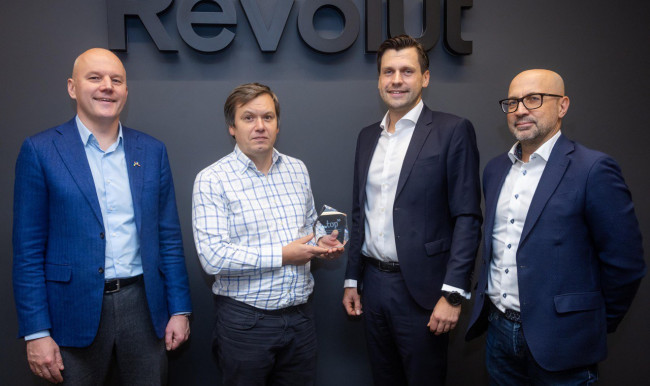
Photo: Publicity images
Five Latvian companies on the list of the most valuable Baltic companies
The combined value of the most valuable companies in Latvia, Lithuania and Estonia exceeded €46.6 billion this year, and many of the companies on the list have shown significant growth during the year. Latvian companies have performed well, growing value faster than Estonian and Lithuanian companies, says Kārlis Krastiņš, Managing Partner and Chairman of the Board at Prudentia, in an interview.
This is the second year that you have compiled the list of the most valuable companies in the Baltics - what are the most significant changes that have taken place in the latest list compared to the previous year, what trends does it show and how have Latvian companies fared?
The performance of Baltic companies is positive, and this also applies to Latvian companies. This year, the first place in the Baltic Top 30 is taken by Thermo Fisher Scientific Baltics, the Lithuanian subsidiary of Thermo Fisher Scientific, the US technology, medical and pharmaceutical giant and a listed company on the stock exchange. The company has performed excellently, increasing both turnover and profits, which has naturally resulted in the Lithuanian company becoming the most valuable company in the Baltics.
Latvian companies have also performed well, growing value faster than Estonian and Lithuanian companies. Therefore, while a year ago the list included three companies whose core business is registered in Latvia (excluding international companies operating in all Baltic countries, such as Rimi), the latest list includes five companies. In addition, Latvian companies are close to the top of the list, ranking 3rd and 4th. The main reason for the success is the successful and ambitious operations, but it is also important to mention the changes made by Swedbank, which have allowed the bank to reach the top of the list already as a company registered in Latvia. Last year, the bank registered its holding company in the Baltics, which invested all the Baltic business owned by Swedbank Sweden, and as a result the value of the Estonian, Latvian and Lithuanian banks is now combined in a single Latvian legal entity, thus strengthening the company's position as Latvia's most valuable company.
Both the Baltic and Latvian manufacturing sectors have performed well. For the first time, Kronospan, a Latvian timber company, has been included in the list as it continues to develop and expand its operations. It is also worth highlighting Mikrotīkls, which is the most valuable Latvian manufacturing company and has successfully managed to climb the rankings. In summary, Latvian companies have also performed well.
Are there any differences between the companies on the list or the sectors they represent in the context of each Baltic State?
A couple of Estonian real estate companies made the list. This sector plays an important role in helping the rest of the economy to grow. In Estonia, the real estate development industry is more concentrated, as can be seen from the amount of capital that has flowed into Latvia and Lithuania. This is one of the differences between the Baltic States - Estonia has a relatively large number of valuable property management companies. Estonia also has a well-developed manufacturing sector, with a greater emphasis on the energy sector. One example is the pellet producer Graanul Invest, one of the largest companies in this field in Europe. The company is owned by a large US investment fund, which also owns Latgran in Latvia. Overall, however, all three Baltic countries have managed to establish themselves globally in the production of industrial goods, and this is also reflected in the growth of company values.
If we talk about Lithuania, the second most valuable company in the Baltics is Vilniaus prekyba, a large holding company, present not only in the Baltics, but also in other European countries, including Scandinavia, which owns such retail brands as Maxima, Akropole, etc. The company has experienced steady growth over the past year and is ranked second among the top 30 most valuable companies. A trading company of this level from Latvia or Estonia has not yet made it to the list of most valuable companies.
Among the Latvian retail companies, the potential for future inclusion in the list is the construction and household goods retailer Depo, as the company is already successfully operating in all three Baltic countries, continuing to build new shopping centres, but, of course, the chances of making the list will depend on the company's further development.
Lithuanians have long been successful not only in trade, but also in logistics. The logistics success of Lietuvos geležinkeliai is also evidenced by the fact that it has additional business lines and infrastructure management that differentiate it structurally from Latvijas dzelzceļš, but it is a company that features prominently in the list of the most valuable companies. ME Investicija, the holding company of the Lithuanian logistics group Girteka, is one of the largest carriers in Europe with a very large number of vehicles and a major player on the market.
State-owned companies play an important role at the top of Latvia's most valuable companies. Are these features also present in the Baltic Top?
In each of the three countries, the top ten is dominated by state and institutional investor-owned companies, but there are also a fair number of private companies.
In Estonia, for example, companies owned by the state or foreign institutional investors - Eesti Energia or SEB Bank Group - top the list.
The situation is different in Lithuania, where, behind the leader Thermo Fisher Scientific Baltics, the runner-up Vilniaus prekyba is a private group owned by three Lithuanian citizens.
You mentioned earlier that five Latvian companies have made it onto the list this year, compared to three previously. What are the factors that have contributed to the better performance of Latvian companies?
The performance of Latvian companies in the Baltic context should be assessed as good, and the number of companies that have made it has indeed increased. The second and fourth most valuable Latvian companies have shown an increase in value, although last year was not the best in terms of EBITDA, as the indicator was affected by the increase in prices of energy and raw materials, as well as other market volatility, which was already evident last year and has continued in full force this year. Latvian energy company Latvenergo AS stood out positively among the other companies, becoming the most valuable energy company in the Baltics. If we look at the increase in the value of the Lithuanian Ignitis group and the Estonian Eesti Energia, which has been split into two companies, Eesti Energia and the listed subsidiary Enefit Green - even adding the two Estonian companies together, Latvenergo's value exceeds them, which is a positive aspect.
It is also welcome that the electricity transmission system operator Augstsprieguma tīkls has made it to the list of the 30 most valuable companies, significantly increasing its value. This is based on the completion of the consolidation of the Inčukalns underground gas storage facility and the transmission system operator JSC Conexus Baltic Grid, during which Augstsprieguma tīkls gained control over the company, and through which the Latvian government has gained control over both the electricity and gas trunklines. Augstsprieguma tīkls used to be part of the Latvenergo Group, but now it is establishing itself as an independent energy infrastructure company. It should be noted that Augstsprieguma tīkls AS is not directly involved in electricity generation, but provides services to the Baltic and other large electricity companies that buy, sell and transport electricity and gas. Augstsprieguma tīkls is a major company, its infrastructure multipliers have increased in Europe, which has also allowed the company to grow its value quite successfully.
What should the companies themselves, and perhaps also the state, do in the coming years to promote Latvian companies on the list of the most valuable companies in the Baltics?
There is no one-size-fits-all prescription or recommendation, as much depends on the sector and the company's own development strategy. But if we are talking about the most valuable companies in the Baltics, then this list should naturally include companies with Baltic ambitions, working throughout the Baltics or, even better, in international markets. Exports, the ability to establish subsidiaries in Lithuania, Estonia, the ability to look to Europe, to build and develop business there, are essential for success. And to run the whole business from Latvia, thus concentrating value in Latvia.
In this context, it should be noted that the list of the most valuable companies in the Baltics could also include other Latvian, Lithuanian and Estonian technology companies that operate globally but for various reasons have not consolidated their businesses in Latvia. In Latvia, for example, there is the well-known Draugiem Group, which owns Printful, Mapon and other successful technology companies. However, for various reasons, Draugiem Group has not consolidated many of its companies into its Latvian holding, so we cannot add up the value of these companies and include them in the TOP30. This is a decision that the group itself takes and we would of course be happy if they did it in Latvia, but we have to understand that the companies operate globally and have chosen not to consolidate here.
In summary, the key factor for a company to make the list of the most valuable companies in the Baltics is global ambition and the ability to realise that ambition.

Photo: Publicity images
During the discussion on Latvia's most valuable companies, it was mentioned that transparency is also an important aspect for a company to be successful globally. It is clear that this area is improving, but it has long been known that Latvian businesses do not always like to be completely transparent. What are your observations, is there progress in this area?
This is an eternal process, because corporate governance and transparency can never be achieved at an ideal level. We have been working on this issue with Nasdaq since day one. Nasdaq assesses corporate governance, its quality, and there are many companies that are already approaching the maximum 100 points.
Which sectors are leading the way?
These are mostly banks, but it has to be said that state-owned companies have also significantly improved their transparency in the last 3-5 years. At the same time, many public and private companies remain relatively secretive. However, if a company wants to be large and international, at some point its shareholders and management will have to realise that transparency and orderliness will lead to better success, cheaper and more profitable financing, easier opening of foreign bank accounts and many other benefits for the company. A company cannot be large and highly confidential at the same time - this combination is impossible. It can work in a small market, in your own town or on a national scale, but on a global, European or Baltic scale it is simply not possible. I think that the moment companies realise that this is good for their business, because it helps to improve profitability and reduce the cost of raising finance, the disclosure process will be much easier and faster. But all this takes time.
This year's TOP is based on 2021 financial figures, but has the impact of this year's war and other shocks already been felt in the latest list?
For the purposes of the list, we use the annual accounts of companies for the previous full year, which is 2021, but for the purposes of determining the value of companies, we take into account stock market multipliers, which we record on 30 June of the current year. Thus, profitability and financial indicators do not yet reflect the impact of the war, but stock market multipliers had already priced in the effects of the war by this time. Of course, stock multipliers vary from market to market, but the overall trend is downwards. However, the results vary by sector and cannot be generalised. The consequences of the Russian invasion of Ukraine will be more visible in next year's top 10, as their impact will be most pronounced in this year's corporate annual reports.
At the outbreak of the war, foreign investors were concerned about the Baltic countries' proximity to Russia, and caution was evident. What are your observations at the moment - are foreign investors currently cautious about Baltic companies and what are the opportunities for our region to attract investment?
Russia's invasion of Ukraine has changed the global security landscape and many security doctrines are being revised. For the Baltic States, Scandinavia and other European countries that share a border with Russia or are close enough to Russia, it is now crucial to demonstrate and prove that they are investing in defence and security by creating a safe and secure environment. This is very important.
The common European and other regional position on Russia as the main security threat to Europe, and possibly the world, is united, and so are the actions, investments and decisions taken globally.
This shows that we also need to continue our work in this area, and the inflow of investment into Latvia and the Baltics from both foreign and domestic investors will depend on whether the investment environment is perceived as safe and promising. Latvia and the Baltic States need to pay serious attention to this and explain both the risks and the opportunities to investors.
So I would say that the current situation is not so bad. In practice, I have observed that foreign investors who are close to the Baltic region understand these risks and understood them earlier, so they calculate them more rationally and pragmatically, which is why investments continue to flow in.
On the other hand, investors who may be further away from the Baltics, and who perceive the distance from Kyiv to Riga as the same as from Kyiv to Kharkiv, have a much fuzzier perception and a more vague understanding of risk levels and are therefore more reluctant to invest, but not all investors have the same attitude.
For example, I have heard of US companies who, given the cooling of US-China relations and the overall trends in the markets, believe that China is becoming riskier as a market, so they are trying to move some of their business to Europe, and they see the Baltics as a great region. This is a trend that can benefit not only Europe, but also the Baltics, so keep an eye on the opportunities.
All the processes that are taking place in the world today are changing many things globally, and I foresee that they may last for years or even decades, they will shape the security situation in the world, which in the future will have a great impact on the Latvian and Baltic economies as well, and we have to take them into account.
Source:
Hāka, Ž. (December 8th, 2022). Vērtīgāko Baltijas uzņēmumu sarakstā iekļuvušas piecas Latvijas kompānijas. delfi.lv. https://www.delfi.lv/bizness/biznesa_vide/vertigako-baltijas-uznemumu-saraksta-iekluvusas-piecas-latvijas-kompanijas.d?id=55014612


